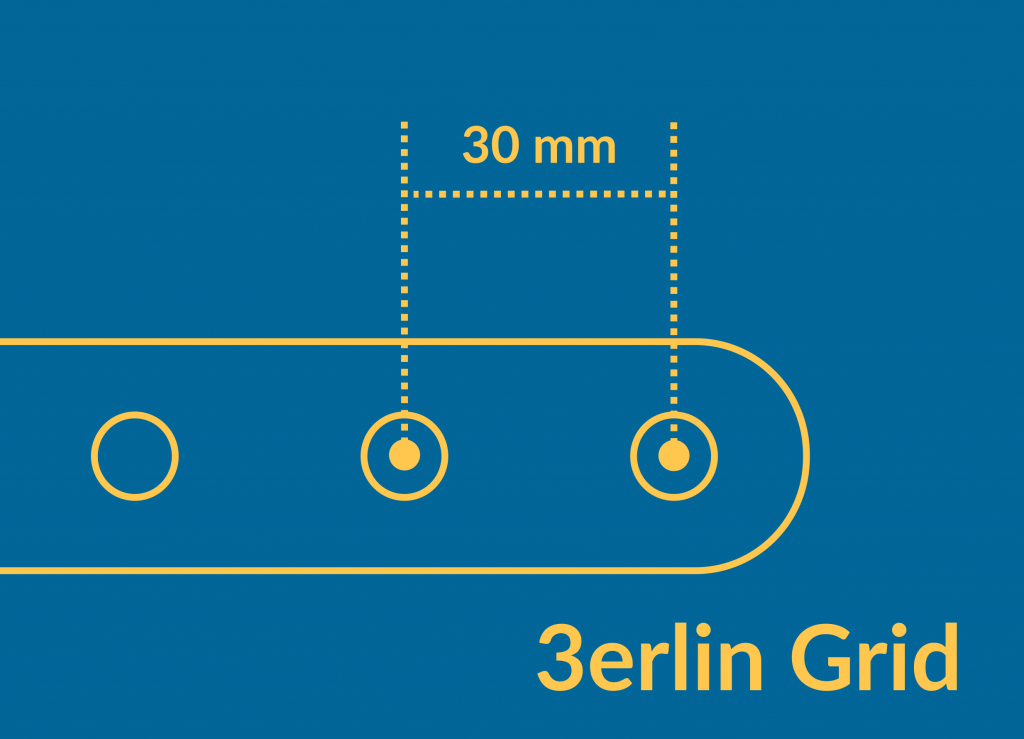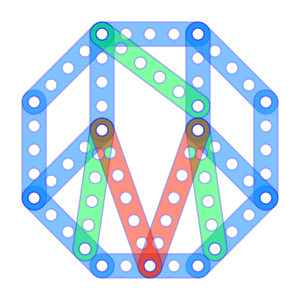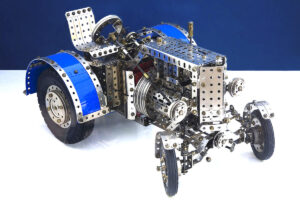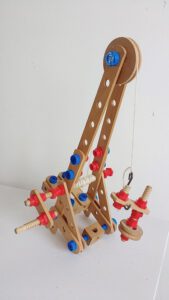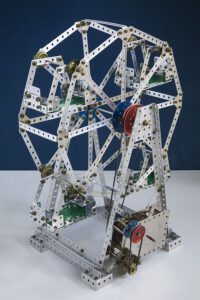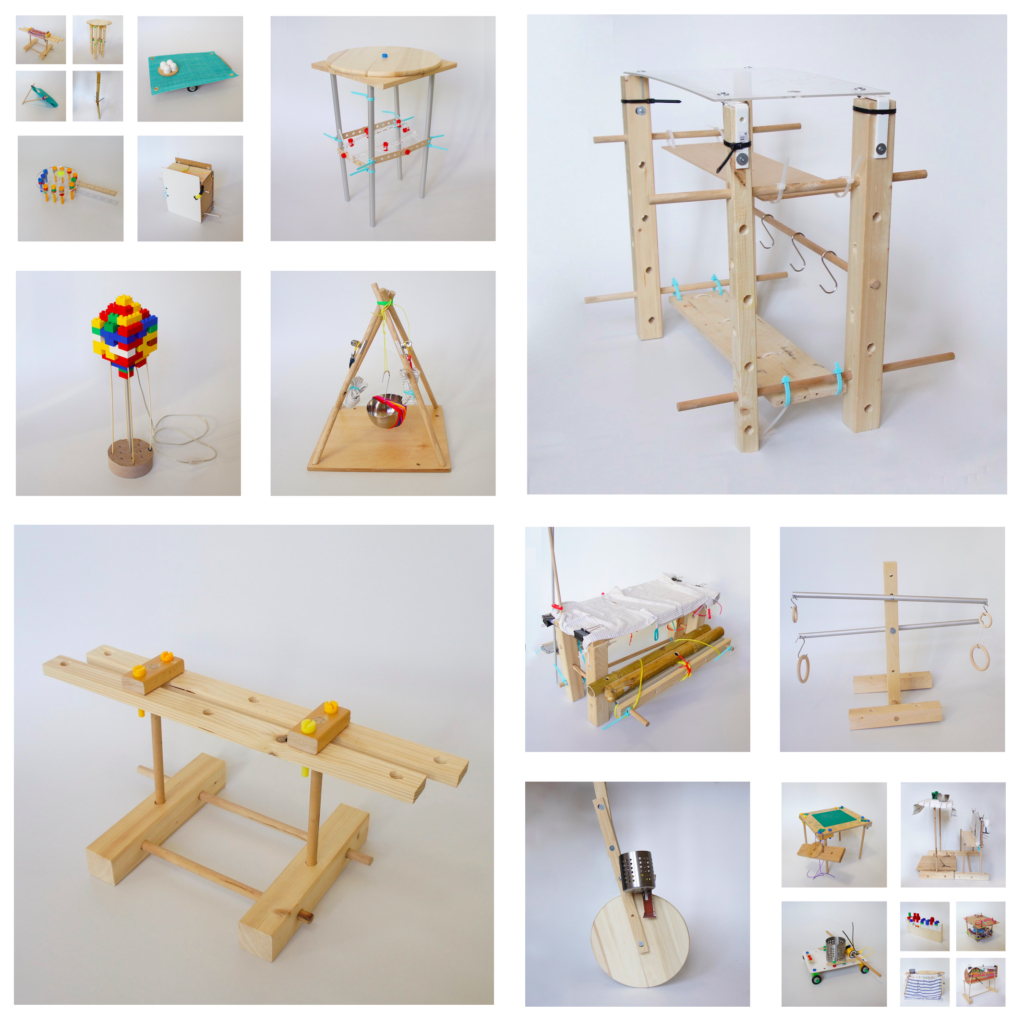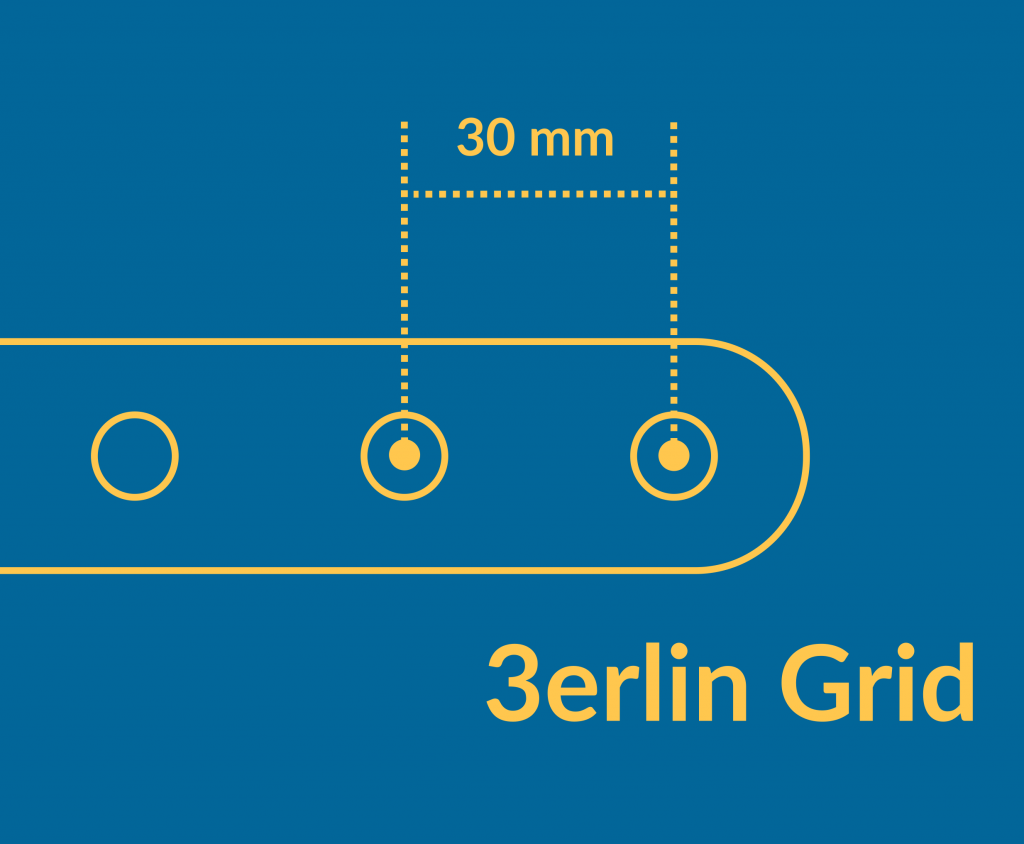Meta
Title: 3erlin Grid Introduction
What: Article
Ordered by: SELF
–
English & Deutsch ↓
–
3erlin Grid
A Universal Construction Grid For Circular Modularity
Almost all of our designs are based on the same geometric grid for 3cm distance between holes – an open standard. This enables reuse and recombination of all parts in our builds and designs. A century old principle of modularity known from children’s toys:
.

–
But why limit this circular design principle to toys? It can work also in other places, right? And bring circularity and reuse to real world objects from furniture to machines.
We are not the first to come up with this idea and we are not the most advanced either. The Open Structures project explores this productively for more than a decade now. The GridBeam project is much older. And the list can be made very long: Contraptor, UniPro, Loose Parts and more.
The 3erlin grid – the grid we work with – has a uniform distance between holes of 3cm. This is derived from the toy “Constructor” (formerly Heros, now Eichhorn) which is well spread in Germany. And we call it the “Berlin Grid” and write “3erlin Grid”. And we invite everyone to use it, it’s open to everyone – an open standard for compatibility between all our designs!
A few projects with the 3erlin grid:
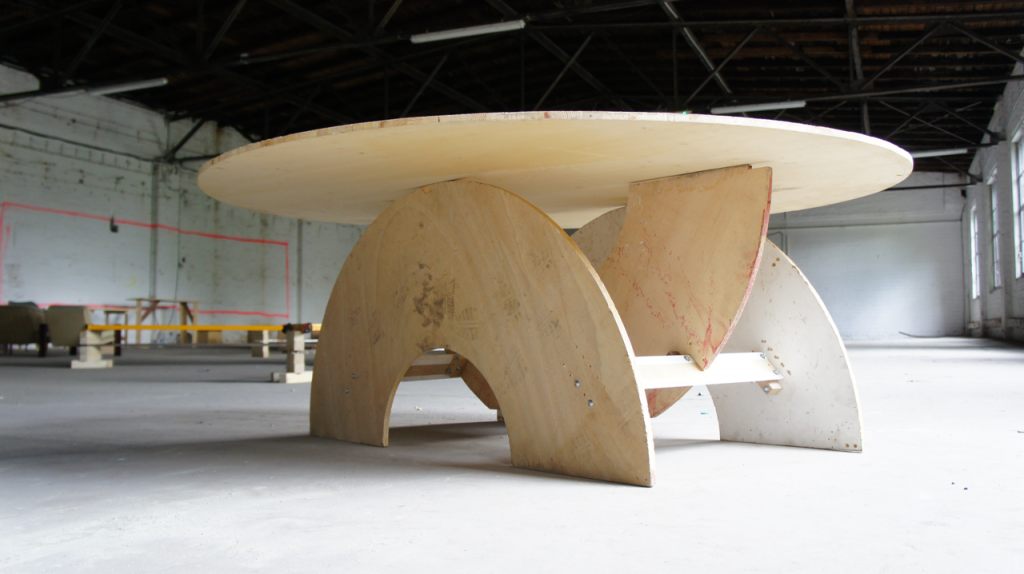

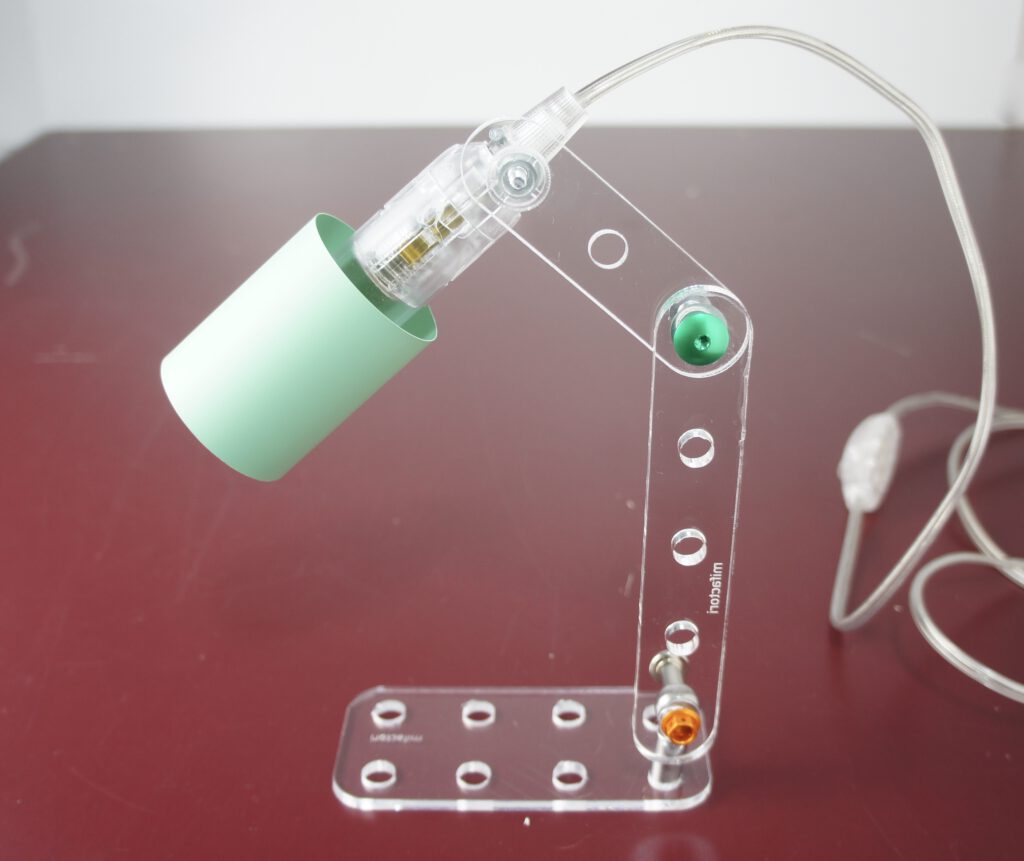
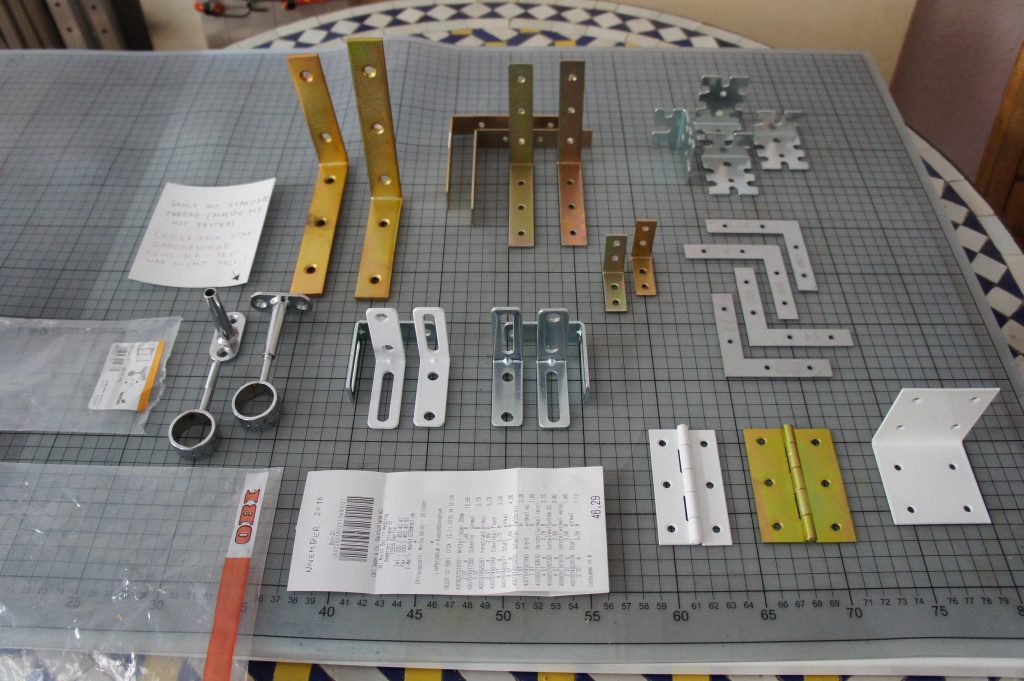
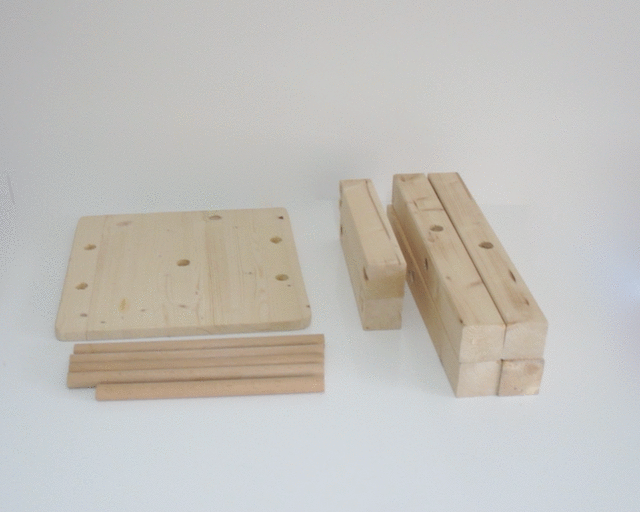
.
More here → 3erlinGrid Category | 3erlinGrid Flickr Tag | #3erlinGrid & #ConsistentGrid hashtag in Social Media
.
pls. read on
↓
–
#ConsistentGrids
Open Decentralized Cooperation And Combinability
Join!
In the core of this design principle lives a sustainability utopia: Imagine that the components of different companies can all combined with each other freely to enable circular network effects of creative reuse and easy repair! A resilient culture with less filled trash bins but more environmental protection and better able to respond to climate change.
The Lego system shows us today how this could look. Since the Lego system has become an open standard a wide variety of actors have plugged into the system producing parts, sets, opportunities and platforms creating effects and making things possible that Lego alone would have not been able to. Everything brought to life through cross-company compatibility of the modules.
But if that is the case it is questionable why we use a 3cm grid when there are much older projects based on other dimensions (4cm uses Open Structures). Why did we aim to create a new grid instead of building on an existing one? Won’t this produce new incompatibilities?
This is really not ideal, but there are historical reasons for it. In fact we are using an existing grid – that of the Constructor toy. When we – inspired by the Open Structures project in 2015 – wanted to work with modular components in public spaces we couldn’t find any Open Structures parts to buy. The project just wasn’t doing that. So we had to buy what was available: Constructor toys. And all parts we added since then follow the grid of parts we already have. That makes sense when all the fun is that you can build more when you have more compatible parts. Today we have a workshop full of compatible parts and our design, education and research work has benefited countless times from it.
.
It’s not THE grid. It’s grids!
.
And over time it turned out that a different distance between holes is currently not that big a problem. The main difficulty is to find effective and simple designs that are based on a universal grid. How do you design products and components that are as universally applicable, reusable and compatible with one another as possible? It usually takes very little effort to translate a solution into another grid. Our open design lamps can be implemented in any grid.
(…)
What does that mean for you now? The grid you use is less important. It is just important that you work with a grid at all. Perhaps you also start with parts that you already have or choose a project whose progress and spirit you like e.g. the Open Structures project or maybe our 3erlin Grid – or you plug into other building systems that are already wide spread and on the market – which might be the smartest move of all.
.
#ConsistentGrids
.
And that’s why we suggest #ConsistentGrids as a common hashtag. Combine it with a more specific hashtag like #OSgrid #3erlinGrid or #GridBeam. But #ConsistentGrids as a cross-grid hashtag can let all experiments learn from each other and collaborate towards a bigger goal.
But one thing is just important to understand:
.
It Won’t Work Without Openness
All of this can only work and lead to positive effects for climate change and sustainability if the parts are also open – open as in Open Source – open in a way that enables and allows others to work creatively and commercially with your results. It won’t make sense to come up with parts that theoretically can be reused everywhere on the planet if then there are legal barriers (unclear property rights) that block these activities! Then it will always be easier and legally safer to do something incompatible. Really sustainable design is not done before the property rights situation is taken care of – something we don’t get tired to mention and explain.
Ok. Thanks for reading. And now go &
.
Gridify The World!
–
Links & Further Information
- 3erlin grid examples here on this page
- 3erlin Grid Examples on Flickr (Tag)
- TED talk about this idea by Thomas Lommée from Open Structures
- Article: “Regenerative Open Structures”
- Article about circular network effects based on uniform open grids
- Short experience report from trying to work with the 3erlin grid on a hackathon
- Concept for an entire teaching and learning system based on the 3erlin grid for a digital teaching laboratory
- Previous version of this article (html & pdf)
- Image Credits below the german version ↓
–
. .^. .
°(◠‿◕)°
. – .
–––––––––
(–O – O – O – O–)
–––––––––
–
Deutsche Version
–
3erlin Grid
Ein universelles Konstruktionsraster für zirkuläre Modularität
Fast alle unsere Designs basieren auf dem selben geometrischen Raster von 3cm – einem offenen Standard. Damit erhöhen wir die Wiedernutzbarkeit und Kombinierbarkeit zwischen allen Bauteilen verschiedener Lösungen. Ein Modularitäts-Prinzip das man von Kinderspielzeugen kennt:

–
Aber warum dieses zirkuläre Designprinzip nur für Spielzeuge einsetzen? Das kann doch auch wunderbar überall anders funktionieren, oder?
Wir sind nicht die ersten, die auf diese Idee kommen und auch nicht die am weitesten fortgeschrittenen. Das Open-Structrues-Projekt exploriert sie sehr produktiv seit über zehn Jahren. Deutlich älter noch ist das GridBeam-Projekt. Und die Liste lässt sich sehr lang machen: Contraptor, UniPro, Loose Parts und mehr.
Das 3erlin Grid – also das Grid mit dem wir arbeiten – hat einen einheitlichen Lochabstand von 3cm. Der ist übernommen vom in Deutschland weit verbreiteten Spielzeug “Constructor” (früher Heros jetzt Eichhorn). Und wir nennen es “Berlin Grid” und schreiben “3erlin Grid”. Und wir laden alle ein, es zu nutzen, es ist offen für alle – ein offener Standard für Kompatibilität.
Ein paar Projekte mit dem 3erlin Grid:
–





.
Mehr hier → 3erlinGrid Kategorie | 3erlinGrid Flickr Tag | #3erlinGrid & #ConsistentGrid Hashtag in Social Media
–
#ConsistentGrids
Offene dezentrale Zusammenarbeit und Kombinierbarkeit
Mitmachen
Im Kern dieses Prinzips wohnt eine Nachhaltigkeits-Utopie. und zwar die Idee, dass die Bauteile verschiedenster Firmen alle miteinander kombiniert werden und zirkuläre Netzwerkeffekte ermöglichen: Alles wird leichter zu reparieren und kreativ weiterzuverwenden. Eine resiliente Kultur, die den Mülleimer selten nutzt und stattdessen die Umwelt schont und besser auf den Klimawandel reagieren kann.
Wie so etwas aussehen kann, zeigt uns das Lego-System. Seit das Lego-System ein offener Standard ist, haben sich vielfältigste Akteure darin eingeklinkt, wodurch Effekte entstanden und Dinge möglich geworden sind, die eine Einzelfirma nicht hätte leisten können. Alles ins Leben gerufen durch firmenübergreifende Kompatibilität der Bausteine.
Aber wenn das der Fall ist, dann ist es fragwürdig, wieso wir ein 3cm Grid nutzen, wenn es ein viel älteres ausgereifteres Projekt (Open Structures) gibt, das auf anderen Maßen (4cm) beruht. Wieso haben wir ein neues Grid geschaffen, anstatt auf ein existierendes aufzusetzen? Es entstehen doch wieder Inkompatibilitäten?
Das ist wirklich ein bisschen dumm, hat aber historische Gründe: Tatsächlich setzen wir ja auf ein existierendes Grid auf – dem des Spielzeugs Constructor. Als wir inspiriert vom Open-Structures-Projekt 2015 mit modularen Bauteilen im öffentlichen Raum arbeiten wollten, gab es keine Open-Structures-Teile zu kaufen. Also haben wir gekauft, was es gab: Constructor-Spielzeug. Und was wir seither selbst produziert haben, folgt dem Grid der Teile, die wir schon haben. Das ergibt Sinn, wenn der ganze Spaß ja ist, dass man mehr verschiedene Sachen bauen kann, je mehr miteinander mehr kompatibler Teile man hat. Heute haben wir eine Werkstatt voller kompatibler Teile und haben in unserer Design-, Bildungs- und Forschungsarbeit schon unzählige Male von der inneren Kompatibilität und Flexibilität unseres gewachsenen Teilezoos profitiert.
.
It’s not THE grid. It’s grids!
.
Und mit der Zeit hat sich herausgestellt, das aktuell ein unterschiedlicher Lochabstand gar kein so großes Problem ist. Die Hauptschwierigkeit besteht darin, effektive und schlichte Designs zu finden, die auf einem einheitlichen Lochraster beruhen. Wie gestaltet man Produkte und Bauteile, die möglichst universell einsetzbar, wiederverwendbar und zueinander kompatibel sind mit einem einheitlichen Lochraster? Die dabei entstehenden Ergebnisse lassen sich dann meistens mit geringem Aufwand in ein anderes Grid übertragen. Unsere Open-Design-Lampen sind in jedem Grid umsetzbar.
(…)
Was heißt das jetzt für euch? Es heißt, dass das Grid, mit dem ihr arbeitet weniger wichtig ist. Hauptsache ihr arbeitet überhaupt mit einem Grid. Vielleicht beginnt ihr auch bei Teilen, die ihr schon habt oder wählt ein Projekt aus, dessen Fortschritt und Spirit ihr mögt, z.B. das Open Structures-Projekt, oder einfach unser 3erlin Grid oder ihr klinkt euch in andere existierende und bereits verbreitete Bausysteme ein – was wahrscheinlich der intelligenteste Weg wäre.
.
#ConsistentGrids
.
Und darum schlagen wir als gemeinsamen Hashtag #ConsistentGrids vor. Der lässt sich immer noch gemeinsam nutzen mit z.B. #OSgrid #3erlinGrid oder #GridBeam. Aber ein Grid-übergreifender Hashtag kann alle Experimentlinien voneinander lernen lassen.
Eines ist bei allem wichtig:
.
Ohne Offenheit funktioniert es nicht
All das kann nur funktionieren und zu positiven Effekten für Klimawandel und Nachhaltigkeit führen, wenn die Teile auch offen sind – also offen im Sinne von Open Source, d.h. in einer Weise, die es anderen erlaubt, kreativ und auch kommerziell mit euren Ergebnissen zu arbeiten. Es macht keinen Sinn, Teile herzustellen, die theoretisch überall auf der Welt kreativ umgenutzt werden können, wenn dann rechtliche Hürden wie Schutzrechte das aktiv blockieren. Dann wird es immer einfacher und rechtlich sicherer sein, etwas inkompatibles zu machen oder zu nutzen. Wirklich nachhaltiges und zirkuläres Design kommt um die entsprechende Gestaltung von Schutzrechten nicht herum, das sagen wir immer wieder und erklären es auch gern.
And now … go &
.
gridify it!
–
Links & Weiterführendes
- 3erlin Grid-Beispiele hier auf dieser Seite
- 3erlin Grid-Beispiele auf Flickr (Tag)
- TED talk über diese Idee von Open Structures
- Artikel: “Regenerative Open Structures”
- Artikel über zirkuläre Netzwerkeffekte basierend auf einheitlichen offenen Grids
- Kurzer Erfahrungsbericht vom Versuch mit dem 3erlin Grid auf einem Hackathon zu arbeiten
- Konzept für ein ganzes Lehr- und Lernsystem basierend auf dem 3erlin Grid für ein digitales Lehrlabor
- Frühere Version dieses Artikels (html & pdf)
–
Image Credits
Image Block 1: (1) Lend_To_Defend_his_Right_to_be_Free_poster_by_Tom_Purvis; Public Domain (2) Leker_-_Fo30141603100027, BY Unknown; CC-BY-SA (3) Munich_-_Deutsches_Museum_-_07-0647, BY Jorge Royan; CC-BY-SA (4) LEGO BRICK; by us, CC-BY (5) BILOfix_crane; BY Vunzmstr; CC-BY-SA (6) Heros Parts; by us; CC-BY (7) Bilofix_motorcycle; Ernst Poulsen; CC-BY-SA (8) Meccano_octagon.svg; BY Jorgeluismireles; CC-BY-SA (9) Munich_-_Deutsches_Museum_-_07-0653; BY Jorge Royan; CC-BY-SA (10) OWi-Logo; by us; CC-BY
Image Block 2: All pictures by us (Mifactori) – CC-BY 4.0
–
. .^. .
°(◠‿◕)°
. – .
–––––––––
(–O – O – O – O–)
–––––––––
